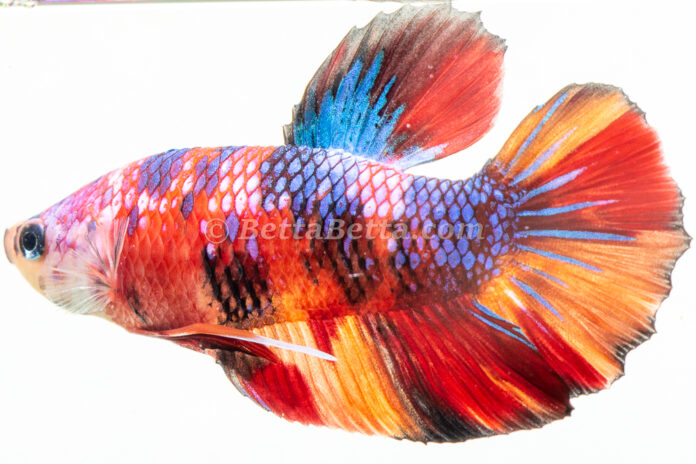Betta breeding can be very time-consuming and expensive. Betta can release over 500 eggs in a single spawn and you will end up with over 300 juveniles to care for if most survive! You must plan and be clear about the objective and goals you want to achieve out of this spawning activity.
The large-scale breeding for supply requires a large investment of time, space, and money. Due to the high startup and supply costs, it is very difficult to make a profit breeding betta, so this should not be your goal for some time.
Are you interested in genetics, supplying a local pet store, or breeding show?
Or are you simply in love with bettas and want to take your hobby to the next level?
When trying to breed any animal, having as much knowledge as you can about the species is important. You must read and research about betta care and breeding. You can breed betta fish at home easily if you follow our guide. So let’s dive into the step-by-step guide to how to breed a betta fish!
Before that see this beautiful video of betta fish breeding! You can even watch betta fish eggs hatching in it
1. FIRST STEP: CHOOSING BETTAS TO BREED
The first thing you need to consider is the age of bettas.
The male must be at least 3 ½ months of age with at least an inch of body length. Males can develop an interest in the opposite sex as early as 2.5 – 3 months but it is advisable to wait until their reproductive system is fully developed.
Females mature faster sexually than males, so make sure that the female is at least 3 months old to ensure that her reproductive organs are fully functioning.
Body length is an important factor in the mating process because they use their bodies to wrap around their female partner. You, therefore, need to make sure that the male is larger than the female!
2. SECOND PHASE: BETTA FISH BREEDING TANK SETUP
Things you may need includes:
- A 10 gallons gallon clear plastic Sterlite tub or an empty 10-gallon tank (be equipped with a removable divider and a few hiding places)
- 25-watt heater: heater set to around 80 °F (27 °C)
- An adjustable filter (such as a sponge filter with a gang valve).
- Lots of Christmas moss
- Indian almond leaf (only available online)
- Plastic wrap
- A light for above the tank
- well-conditioned Bettas (preferably siblings)
Your breeding tank should not have gravel or other substrates as the falling eggs can get lost at the bottom.
Only fill the tank with 5″-6″ of water and should be clean and free of any parasites and harmful bacteria. You will also need to provide a structure that will enable the female to either run away or hide from the male if she needs to. The way to do that is to add some plants, driftwood, or artificial plants near one side of the aquarium. The purpose of this structure is to provide an escape route and a safe haven for the female during those times that she needs to get away from her aggressive male suitor. This is important because otherwise, the male could kill the female during the mating process if the female has no way to escape him.
3. THIRD PHASE: OBSERVING THE BEHAVIOUR
Put the pair in separate containers or the same container with a divider so they can see each other.
However, at the same time, you need to be able to provide a non-transparent barrier that you can put between them when needed. This barrier could be cardboard or anything opaque that will prevent them from seeing each other.
Remove the non-transparent barrier every once in a while, (about every 3 days) to see the pair’s reaction to each other’s presence.
If they are ready to breed, you should see a frenzied reaction from them that looks like they are “going at each other” the moment they are aware of each other’s presence.
The male will swim around, displaying his fins, flaring and will also create a bubble nest, and the female will display dark vertical striped on its body (usually visible only on dark-colored betta females).
4. FOURTH PHASE: THE PREPARATION
- Set the temperature to 76 – 80 degrees Fahrenheit.
- Increase the frequency with which you feed the targeted pair for a week or two before introducing them to their mating tank. The increased feeding is important to do because they will need a lot of energy for the mating process.
When feeding, you also need to pay attention to the amount of food that you provide, because overfeeding can cause a disease called “dropsy”, where the fish’s body will swell, and the scales stand up. (It is very difficult to cure a betta of this disease).
- Perform frequent water changes (~50% water change every 2 days) and add salt (about ¼ tsp non-iodized salt per 10 gallons) to the tank with every water change.
It is also helpful to introduce tannins with every water change. There are several ways to do this. The quickest way is to let a tea bag soak in the tank until the water gets light to medium brown in color. You can also brew the tea first, then let it cool to roughly the same temperature as your aquarium before adding it to the tank. You can also add tannins to the tank by first microwaving a dried brown leaf for 30 seconds to kill any bacteria, then placing it into the tank. Use a medicine dropper to add 10-20 drops of the tea to the tank.
- Position the escape structure near the filter. This way the filter can provide additional structure behind which the female can hide and escape, and it can also provide a source of oxygenated water to help the female recover from the numerous chasings and bitings that she will typically suffer during the spawning ritual.
- Position the heater and targeted spawning area opposite the filter and escape structure – diagonally opposite is preferable. You want to have the source of heat close where the fry will hatch and where the pair will mate. Position the targeted spawning area diagonally on the opposite side of the filter ensures that the targeted spawning area has little or no water movement.
For the spawning area, the classic approach is using a half Styrofoam cup or a piece of waxed paper to provide the platform for the male to build his bubble nest.
My preference is to use a dried leaf (Indian Almond/Cattapa leaf) and/or a floating water sprite plant. The reason for using the dried leaf is because it not only provides a bubble nest platform but also produces tannins beneficial to the mating pair. Use additional tea bags in the spawning tank if needed to help induce the spawning action. The leaves of the water sprite provide a natural platform for the male’s bubble nest, its roots provide a natural hiding place for the fry, as well as a platform for infusoria to accumulate. The water sprite will also help to absorb the toxins in the water such as ammonia, nitrites, etc. (Recently I found that the male bettas will also create bubble nests under duckweed.)
- Lower the water level in the tank down to a depth of about 4 to 6 inches so that the male will not have to spend as much energy trying to retrieve the falling eggs from the bottom of the tank and placing them in the bubble nest.
5. FIFTH PHASE: INTRODUCING MATING PAIR AND SPAWNING
It is best to place the two members of the mating pair into the tank one at a time instead of simultaneously. You can start with either sex, but my preference is to start with the female and put her behind a transparent barrier so that the male can see her. This transparent barrier (usually referred to as the “transparent chute”) could be a clear soda bottle with the bottom cut off. Introduce the male to a section of the aquarium where he will not readily see the female. Let the male adjust to the new environment and allow him to discover his mate.
Set the temperature to 81- 82 degrees Fahrenheit. This change in temperature will help induce them to be in spawning conditions.
Once the male sees his mate, he should be showing interest in getting to her and will start flaring his fins to show off. The female should respond positively by showing vertical marks on her body, flaring her fins, and/or acting like she wants to get to the mate also.
If they do not exhibit such behavior, introduce more tannins. There is no lethal dosage for tannins so do not worry if the water becomes dark brown. Once they exhibit this behavior, time the release of the female when the male is not around or is otherwise out of the male’s view. The process of discovery helps increase the chances of a successful spawn.
The pair should start spawning in 48-72 hours. Chances are that they will spawn 99% of the time if you follow the procedure described above. If they do not, other things you can try include:
- Introducing an additional female into the tank
- Changing either member of the mating pair and/or
- Repeating this process from the beginning.
Introducing another female into the tank is suggested because this may trigger the bettas’ natural aggressive nature, which in turn will lead to spawning action.
The suggestion to change either member of the mating pair is based on the observations of many breeders that individual bettas have definite preferences when it comes to mates. One female will show its vertical marks to one male but not to another male, and another male will show no interest in one female, but will actively pursue another female. Changing the female can be a good option as it is reported to result in spawning within 2 days.
It is recommended to keep the lights of the mating tank on day and night from the time the mating pair are introduced to the mating tank up until the fry is free-swimming. There is one school of thought that believes that constant light helps induce spawning and also helps the male take care of the eggs so that they will hatch.
6. SIXTH PHASE: POST SPAWNING PROCEDURES
Remove the female the moment the spawning process has ended. An indicator that the process has ended will be the observation that the female is staying away from the bubble nest for a long period of time after she releases the last batch of eggs. You must take the female out of that tank the same day the spawning is completed. Otherwise, she will be very tired and hungry and will, therefore, be very tempted to eating those eggs to replace her spent energy.
You can keep the male with the fry for up to 5 days to take care of the fry. Double the water level at this point to reduce the amount of toxic elements in the water.
Check this video of Betta fry to get amusement!https://www.youtube.com/embed/SlZsnkK1Ho8
Feed the male with Baby Brine Shrimp(BBS). The bigger fry eats them also, which helps them grow faster. You can feed the smaller fry with an infusoria (using a medicine dropper) and a micro worm combination the moment they are free-swimming. They typically free swim within 2-3 days after the spawn. To culture infusoria, put java moss into a container with used aquarium water. Add Liquifry No. 1 into that container and let it sit 2-3 days before siphoning it out with a medicine dropper. In the absence of Liquifry No. 1, you can use fresh egg yolk as a substitute.
On the 3rd day of feeding, add vinegar eels as part of the fry menu. On the 5th day of feeding, stop feeding infusoria but continue with the vinegar eel and micro worm combination. At the same time, feed the father and larger fry with BBS.
I typically keep a Chinese Golden Algae Eater in the spawning tank so that it can eat any uneaten food and debris, thus helping to minimize the development of waste byproducts from rotting food, as this would be lethal to the fry. I also add 3-5 drops of Tetra Aqua Easy Balance per 10 gallons every week to the tanks as a precaution.
CONCLUSION
All in all, I would say that the key to increasing your chances of a successful spawn is CHANGE. Change in the temperature, feeding pattern, water quality, mating environment, and mating partners. Follow these guidelines, and I’m sure you’ll be successful!


